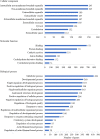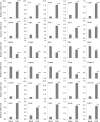Deer antler extract potentially facilitates xiphoid cartilage growth and regeneration and prevents inflammatory susceptibility by regulating multiple functional genes
- PMID: 33752715
- PMCID: PMC7983396
- DOI: 10.1186/s13018-021-02350-4
Deer antler extract potentially facilitates xiphoid cartilage growth and regeneration and prevents inflammatory susceptibility by regulating multiple functional genes
Abstract
Background: Deer antler is a zoological exception due to its fantastic characteristics, including amazing growth rate and repeatable regeneration. Deer antler has been used as a key ingredient in traditional Chinese medicine relating to kidney and bone health for centuries. The aim of this study was to dissect the molecular regulation of deer antler extract (DAE) on xiphoid cartilage (XC).
Methods: The DAE used in this experiment was same as the one that was prepared as previously described. The specific pathogen-free (SPF) grade Sprague-Dawley (SD) rats were randomly divided into blank group (n =10) and DAE group (n =10) after 1-week adaptive feeding. The DAE used in this experiment was same as the one that was prepared as previously described. The rats in DAE group were fed with DAE for 3 weeks at a dose of 0.2 g/kg per day according to the body surface area normalization method, and the rats in blank group were fed with drinking water. Total RNA was extracted from XC located in the most distal edge of the sternum. Illumina RNA sequencing (RNA-seq) in combination with quantitative real-time polymerase chain reaction (qRT-PCR) validation assay was carried out to dissect the molecular regulation of DAE on XC.
Results: We demonstrated that DAE significantly increased the expression levels of DEGs involved in cartilage growth and regeneration, but decreased the expression levels of DEGs involved in inflammation, and mildly increased the expression levels of DEGs involved in chondrogenesis and chondrocyte proliferation.
Conclusions: Our findings suggest that DAE might serve as a complementary therapeutic regent for cartilage growth and regeneration to treat cartilage degenerative disease, such as osteoarthritis.
Keywords: Deer antler extract; Growth; Molecular regulation; RNA sequencing; Regeneration; Xiphoid cartilage.
Conflict of interest statement
The authors declare that they have no competing interests.
Figures



Similar articles
-
Investigating the molecular control of deer antler extract on articular cartilage.J Orthop Surg Res. 2021 Jan 6;16(1):8. doi: 10.1186/s13018-020-02148-w. J Orthop Surg Res. 2021. PMID: 33407721 Free PMC article.
-
Antler extracts stimulate chondrocyte proliferation and possess potent anti-oxidative, anti-inflammatory, and immune-modulatory properties.In Vitro Cell Dev Biol Anim. 2018 Jun;54(6):439-448. doi: 10.1007/s11626-018-0266-2. Epub 2018 May 30. In Vitro Cell Dev Biol Anim. 2018. PMID: 29850973
-
Proteomic analysis of the effects of antler extract on chondrocyte proliferation, differentiation and apoptosis.Mol Biol Rep. 2019 Apr;46(2):1635-1648. doi: 10.1007/s11033-019-04612-1. Epub 2019 Jan 24. Mol Biol Rep. 2019. PMID: 30680597
-
The contribution of deer velvet antler research to the modern biological medicine.Chin J Integr Med. 2014 Oct;20(10):723-8. doi: 10.1007/s11655-014-1827-1. Epub 2014 Oct 16. Chin J Integr Med. 2014. PMID: 25319223 Review.
-
Deer antlers: a zoological curiosity or the key to understanding organ regeneration in mammals?J Anat. 2005 Nov;207(5):603-18. doi: 10.1111/j.1469-7580.2005.00478.x. J Anat. 2005. PMID: 16313394 Free PMC article. Review.
Cited by
-
The Therapeutic Potential of Intra-Articular Injection of Synthetic Deer Antler Peptides in a Rat Model of Knee Osteoarthritis.Int J Mol Sci. 2024 May 30;25(11):6041. doi: 10.3390/ijms25116041. Int J Mol Sci. 2024. PMID: 38892229 Free PMC article.
-
Health Effects of Peptides Extracted from Deer Antler.Nutrients. 2022 Oct 8;14(19):4183. doi: 10.3390/nu14194183. Nutrients. 2022. PMID: 36235835 Free PMC article. Review.
-
Revisiting morphology of xiphoid process of the sternum in human: a comprehensive anatomical study.Surg Radiol Anat. 2024 Oct;46(10):1687-1692. doi: 10.1007/s00276-024-03463-1. Epub 2024 Aug 22. Surg Radiol Anat. 2024. PMID: 39172258
-
Use of Network Pharmacology and Molecular Docking Technology to Analyze the Mechanism of Action of Velvet Antler in the Treatment of Postmenopausal Osteoporosis.Evid Based Complement Alternat Med. 2021 Oct 11;2021:7144529. doi: 10.1155/2021/7144529. eCollection 2021. Evid Based Complement Alternat Med. 2021. PMID: 34671409 Free PMC article.
-
Inbreeding depression and the probability of racing in the Thoroughbred horse.Proc Biol Sci. 2022 Jun 29;289(1977):20220487. doi: 10.1098/rspb.2022.0487. Epub 2022 Jun 29. Proc Biol Sci. 2022. PMID: 35765835 Free PMC article.
References
MeSH terms
Substances
Grants and funding
LinkOut - more resources
Full Text Sources
Other Literature Sources

